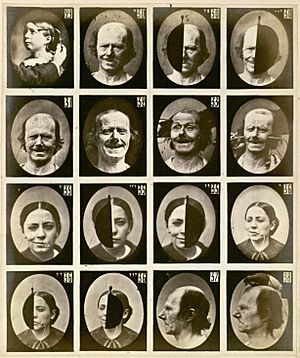Facial expression facts for kids

A facial expression results from one or more motions or positions of the muscles of the face. These movements show the emotional state of the person to observers. Facial expressions are a form of nonverbal communication. They are a primary means of conveying social information among humans, but also occur in most other mammals and some other animal species.
Humans can adopt a facial expression as a voluntary action. However, because expressions are closely tied to emotion, they are more often involuntary. It can be nearly impossible to avoid expressions for certain emotions, even when it would be strongly desirable to do so; a person who is trying to avoid insult to an individual he or she finds highly unattractive might nevertheless show a brief expression of disgust before being able to reassume a neutral expression. The close link between emotion and expression can also work in the other direction; it has been observed that voluntarily assuming an expression can actually cause the associated emotion.
Some expressions can be accurately interpreted even between members of different species- anger and extreme contentment being the primary examples. Others, however, are difficult to interpret even in familiar individuals. For instance, disgust and fear can be tough to tell apart.
Facial expressions
Some examples of feelings that can be expressed are:
Images for kids
-
An actor acting out Drama Masks (Thalia and Melpomene) in 1972.
See also
 In Spanish: Expresión facial para niños
In Spanish: Expresión facial para niños


